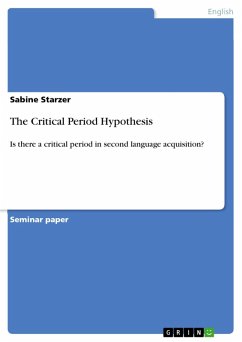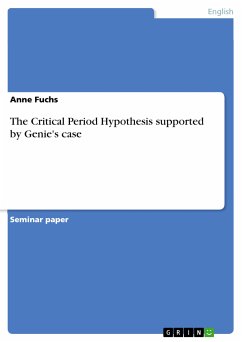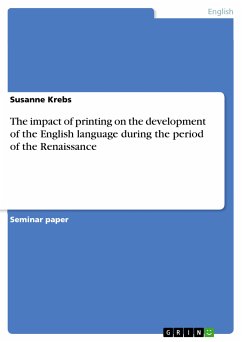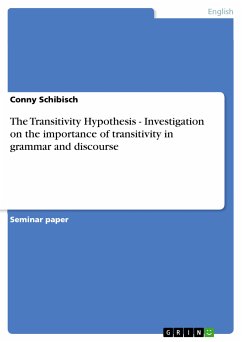Seminar paper from the year 2004 in the subject English Language and Literature Studies - Linguistics, grade: 1,3, University of Dusseldorf "Heinrich Heine", course: PS Language Acquisition, language: English, abstract: In his fundamental work, “Biological Foundations of Language”, the biolinguist Eric Lenneberg presents, among other things, his “Critical period” hypothesis. It consists, roughly, in the idea that a certain age is appropriate for learning a language, so that it is impossible to achieve full competence before or after it. In this essay, I will focus on the second borderline, which is usually drawn by later interpreters at the beginning of puberty – the reasonability of this will be discussed in the next chapter of this essay. Lenneberg subdivides the ongoing process of lateralization into five levels: an infant up to 20 months has identical hemispheres without functional differences; a toddler up to 36 months develops a preference for either the right or the left hand, but the responsibility for language still can easily switch an other hemisphere; a child up to 10 years is still able to reactivate language functions in the right hemisphere; in the early puberty – up to 14 years – the equipotentiality rapidly declines, and after that it is lost completely. Lenneberg talks about a “reactivation”, not “creation” of the language function in the right hemisphere. He thereby implies that at the beginning this function is present in both hemispheres and later (partly) disappears from the right one; it does not develop in the left half of the brain only right from the start (with the option to migrate to the other hemisphere in emergency cases during the childhood). According to later studies, he was right in this point; apparently, he even overrated the monopolistic role of the left hemisphere as he wrote that in about 97% of the entire population language is definitely lateralized to the left (p. 181). He wrote the “Biological Foundations…” in 1967, ten years before the Russian scientists Balanov, Deglin and Chernigowskaya proved experimentally that every hemisphere contains certain speech ability: they caused a temporary aphasia of one hemisphere in healthy persons and detected that people with a blocked hemisphere were able to talk – even if it was the left one. In that case the used vocabulary shrunk, the test persons spoke very little, in short simple sentences, and only about concrete, visible objects, whereas persons with the right hemisphere blocked became very talkative, fantasized, used complicated grammatical constructions and a lot of abstract terms.








